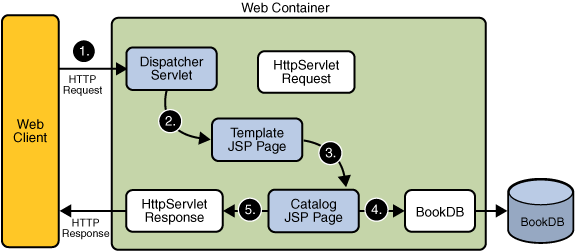
The Example JSP Pages
This chapter describes the tasks involved in defining simple tags. We illustrate the tasks using excerpts from the JSP version of the Duke's Bookstore application discussed in The Example JSP Pages (page 97), rewritten here to take advantage of several custom tags:
The
tutorial-templatetag library defines a set of tags for creating an application template. The template is a JSP page that has placeholders for the parts that need to change with each screen. Each of these placeholders is referred to as a parameter of the template. For example, a simple template might include a title parameter for the top of the generated screen and a body parameter to refer to a JSP page for the custom content of the screen. The template is created using a set of nested tags--definition,screen, andparameter--that are used to build a table of screen definitions for Duke's Bookstore. Aninserttag to insert parameters from the table into the screen.Figure 7-1 shows the flow of a request through the following Duke's Bookstore web components:
template.jsp, which determines the structure of each screen. It uses theinserttag to compose a screen from subcomponents.screendefinitions.jsp, which defines the subcomponents used by each screen. All screens have the same banner but different title and body content (specified by the JSP Pages column in Figure 4-1).Dispatcher, a servlet, which processes requests and forwards totemplate.jsp.

Figure 7-1 Request Flow through Duke's Bookstore Components
The source code for the Duke's Bookstore application is located in the
<INSTALL>/javaeetutorial5/examples/web/bookstore3/directory created when you unzip the tutorial bundle (see About the Examples, page xxx). To build the example, follow these steps:
- In a terminal window, go to
<INSTALL>/javaeetutorial5/examples/bookstore3/.- Run
ant. This target will spawn any necessary compilations, copy files to the<INSTALL>/javaeetutorial5/examples/web/bookstore3/build/directory, package a WAR file, and copy it to the<INSTALL>/javaeetutorial5/examples/web/bookstore3/dist/directory.- Start the Application Server.
- Perform all the operations described in Accessing Databases from Web Applications (page 54).
To deploy the example, run
antdeploy. Ignore the URL that the deploy target gives you. To run the application, use the URL given at the end of this section instead.To learn how to configure the example, refer to the
web.xmlfile, which includes the following configurations:
- A
display-nameelement that specifies the name that tools use to identify the application.- A
context-paramelement that specifies the JSTL resource bundle base name.- A
listenerelement that identifies theContextListenerclass used to create and remove the database access.- A
servletelement that identifies theDispatcherinstance.- A set of
servlet-mappingelements that mapDispatcherto URL patterns for each of the JSP pages in the application.- Nested inside a
jsp-configelement is ajsp-property-groupelement, which sets the properties for the group of pages included in this version of Duke's Bookstore. See Setting Properties for Groups of JSP Pages (page 144) for more information.To run the example, open the bookstore URL
http://localhost:8080/bookstore3/bookstore.See Troubleshooting (page 60) for help with diagnosing common problems.